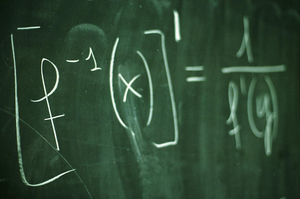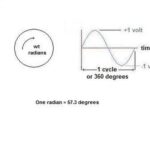When we “see” a sound wave projected onto a visual screen, we see a wave. We describe music in terms of waves, in cycles per second or Hz. We use wave talk to discuss notes, speaking in frequencies and amplitudes. But then, without warning, someone starts spewing trigonometry at us like a high school mathematics teacher. What do triangles have to do with sound?
Sine and Waves
If we remember our trigonometry, which most of us don’t, we would remember sine (or “sin” if you grew up with calculators) is a ratio of the two legs of a right triangle. The ancient Greeks discovered that if you knew those two legs, you knew the angles of the triangle as well, and they related it all in terms of sine, cosine, and tangent. These are called “functions.” Speaking roughly, they “eat” an angle that you tell them, and they spit out the ratio between the two legs of a right triangle that has that angle.
A funny thing happens when you combine sine, a triangle function, with graph paper. As you graph the values of sine as you travel around the 360 degrees of a circle, it makes a wave. The wave is, on its surface, nothing special, but behind the scenes, coincidences in slopes, angles, derivative properties, and many other convenient things come together to make sine, and its cousins cosine and tangent, among the most useful concepts in mathematics.
Instruments and Waves
Instruments make sounds by spewing compression waves at us. These are waves of compressed or decompressed air which are concentrated into out ears and interpreted as sound. These waves are fairly regular, and some of that regularity determines the note we hear. Within the big wave of a note, called the fundamental, are smaller waves, called harmonics, that each instrument makes. These help determine the unique sound of the instrument.
Putting It Together
Musical sound is made up of many of these waves, adding and subtracting from one another. This would be quite hard to model, but math makes it easy. A property of sine waves makes them universal approximators of other waves. Essentially, given a wave, you can create a sum of other sinusoidal (that means “made from sine”) waves that approximate the wave in question.
Thus, we can speak of instruments by separating out sine waves in the fundamental and overtone series, and by adding them, subtracting them, or reworking them, get a better understanding of the sound. Whenever we talk about waves, we often, but not always, use sine as a convenient wave “building block” and with music, the shape is especially perfect.
If you are interested in learning more about music, I recommend paying a lot of attention in math and physics class. Yes, they are going to bore you with falling objects, electric currents, and an endless array of right triangles, but in the end, the same skills transfer over into the realm of arts and music seamlessly, and you can become a better musician for understanding it.
Sources:
UNSW: FAQs in Music Acoustics
BePress.com: A “Sound” Approach to Fourier Transforms: Using Music to Teach Trigonometry by Bruce Kessler






